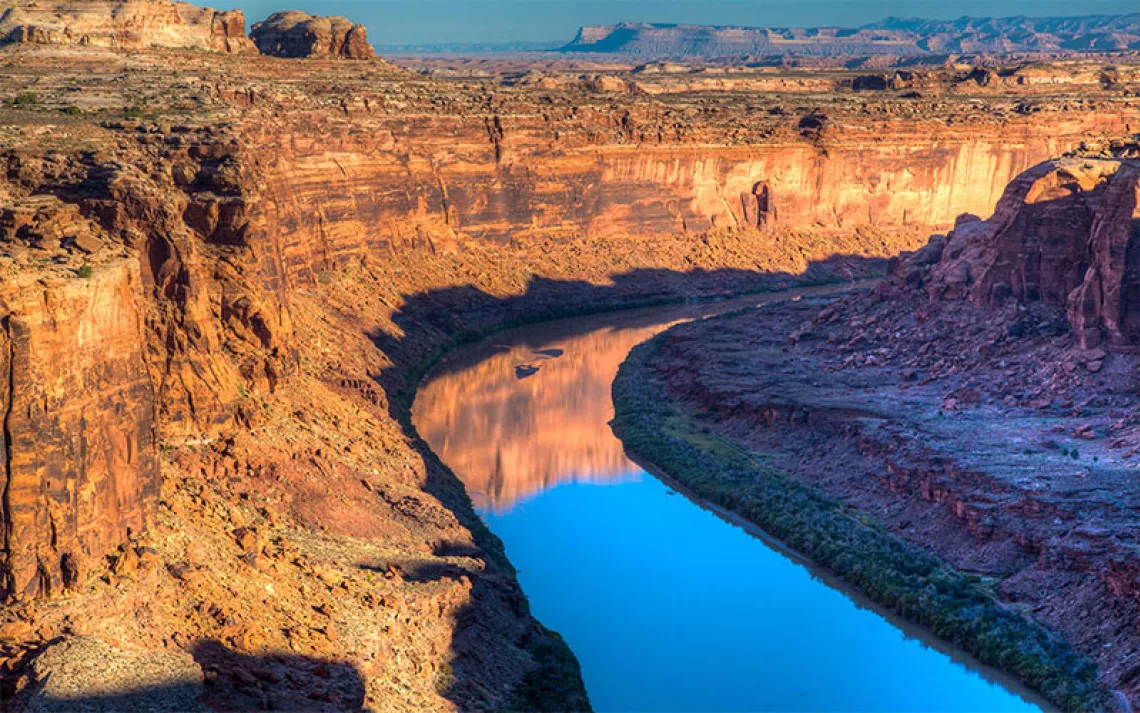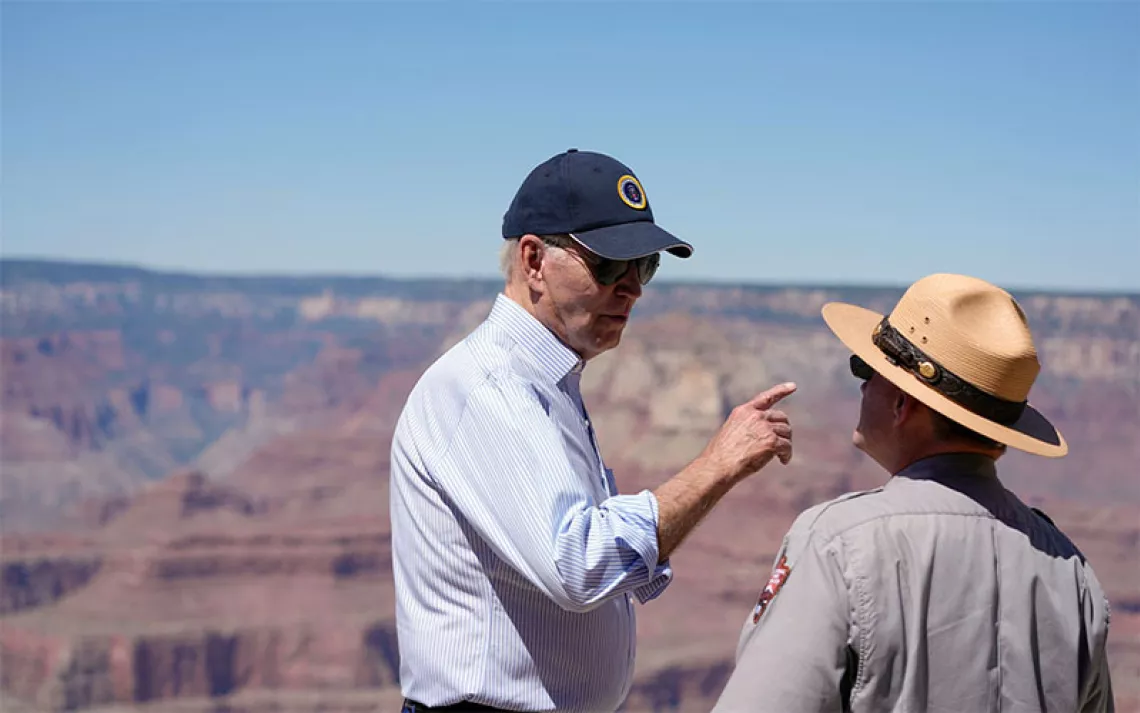The Curious Case of the Rabbit Mountain Elk
In Colorado, residents clash over a plan for managing wildlife

The Rabbit Mountain elk can be found grazing in the Ron Stewart Preserve and in the plains below Indian Mountain. | Photos By Dana Romanoff
FROM THE BULGING PEAK of Rabbit Mountain, at 6,000 feet on the edge of the foothills north of Boulder, Colorado, you can watch a transition unfold. To the east, a tabletop of pasture and farmland spreads out to the horizon. To the west, the Rocky Mountains rise impenetrably. Pale rock ripples north toward Wyoming, and in the south, a basin funnels rivers to Denver.
Positioned like an island in the plains just east of the Continental Divide, Rabbit is part ponderosa forest, part shrubby foothill, and part grassland. This convergence hosts a greater variety of flora and fauna than can be found almost anywhere else in the Front Range. There is human overlap as well. Tepee rings are preserved not far from rusted exploratory oil wells. Cornfields lie within sight of a limestone quarry. Museumified homesteads linger near recently unpacked mansions. Rural sensibilities abut urban sensitivities.

Thistles in the surrounding plains.
The trouble started in the early 2000s, when the elk showed up.
At first there were just a few—a pioneering group that had come down from the sheer heights of the Rockies. Unlike other herds that trekked to the foothills to wait out the harsh upper-elevation winters and returned to alpine meadows come spring, these elk had exchanged their migratory habits for permanent residence on Rabbit Mountain.
They idled away the hot days in the shade of pines and gorged in fields of alfalfa by night—protected and well-fed. The elk's numbers exploded to more than 350, and their impact became irrefutable. The mountain's unique Venn diagram of an ecosystem began to show wear. Nearby roads earned a frightful reputation for evening collisions. Neighboring farmers complained of lost crops and damaged fences. Something had to be done.
To complicate matters, Rabbit Mountain was a critical part of a Boulder County land-use system established in the 1960s to protect habitat from development and degradation. Deemed a preserve, it was by definition a wildlife refuge. Most proposals to curb the growing elk population required some form of heavy-handed management—likely the killing of animals in a community with varying, and at times opposing, ideologies about hunting, habitat restoration, and recreation.
So in 2017, when the first modern hunter set foot on Rabbit Mountain, there was a sense that something significant had changed in this place of transition at the eastern edge of the West.
"DON'T LOOK IN THE HOLES unless you want to see a rattler," warns Boulder County biologist Dave Hoerath. I look in every one but see no snakes.
We are walking through a prairie-dog town, carefully picking our steps over loose rocks and prickly pear on our way up Rabbit Mountain. It's April, the sun is rising, and the morning air is crisp. Hoerath, clean-shaven, shaggy-haired, and wearing dark sunglasses and a fanny pack, is leading me on a mission to haze the elk, to "make their lives as uncomfortable as possible" by chasing them around the preserve. He stops often to point out the flowers: chimney bellflowers, sand lilies, death camas.

Boulder County Parks and Open Space hunt coordinator Jenny Dalton
We follow a hoof-worn trail up the west slope, past shrubs and boulders, over rusted barbed wire left behind by ranchers, and into a stand of Rocky Mountain sumac. "We're trying to train them to like that end of the world," Hoerath says, pointing at the mountains behind us, where he hopes the herd will return. So far, though, they seem pretty happy here.
Elk are heavy grazers, and everything around us has been trimmed to hip height. Branches of the mountain mahogany, a key player in Rabbit's ecosystem, can take a century to reach full span; here, they have been nibbled to woody clubs. Pungent sap bleeds from antler scrapes in pine trees. The ground is churned over by elk hooves. There are droppings everywhere.
Rabbit Mountain is the dominant feature of the 2,871-acre, county-managed Ron Stewart Preserve, and it could support some elk, Hoerath explains, but not in the present numbers and not so tightly packed. He points out a six-foot-high temporary fence that the county installed recently to keep elk out of the ponderosa pine groves. There are a few of these around the preserve, and he hopes they will encourage the elk to move on, but this fence is already bent low in places where the herd has sussed out its weaknesses.
The mountain is one of three county holdings listed as having outstanding, and threatened, biodiversity because of their globally imperiled ecosystems and species, including the Bell's twinpod, a small yellow flower. Noting this exceptionalism, Boulder County in 1984 purchased the first 1,119 acres that would become the preserve.
Colorado's unique open-space movement began in the city of Boulder in 1967. Later, in 1978 and then 1988, Boulder residents tried but failed to pass a city tax that would fund the protection of old ranches and undeveloped land from the vulgarities of unchecked growth (a new tax finally passed in 1993). In the years since, the system has expanded well beyond its original 85 acres. Boulder County now manages 65,767 acres of publicly owned open space, about two-thirds of which is available for recreation. Almost 20,000 acres are leased for agriculture, and 5,500 acres are set aside for other purposes, including wildlife protection. Until the elk showed up on Rabbit Mountain, hunting was not allowed on any of the open-space land.

The view southwest from Rabbit Mountain
A funky, barnyard smell hangs in the air, and we see figures stir among the trees about 60 yards ahead. The elk, which have been wise to us for some time, don't wait around. They rush west off the ridge, scattering rocks and cracking limbs as their heavy bodies leap toward safety. We follow in vain, then stare dumbly as they escape in one solid, undulating mass of brown fur and heavy hoof. The lead animal, a radio collar around her neck, forges north before swinging back east, taking them all farther into the park.
Now is the time for environmental journalism.
Sign up for your Sierra magazine subscription.

"If we had 20 people, we may have been able to corral them, but that's a lot of radios, a lot of training, just for something that doesn't work very well," Hoerath says. He leads a few volunteers on expeditions like this almost every week between January and May, at which point the elk start calving. I ask, "If the goal is to thin the herd, why stop at calving, when they're most vulnerable?" Hazing them might force the herd to abandon calves in the field, he answers. "It's just not palatable, even though it might be effective."
Shooting animals on open-space land has not been particularly palatable either. Recognizing the limitations of hazing, the county recently took baby steps to bring recreational hunters onto the preserve, hoping that the pressure would reduce the elk population and force them to migrate. Hoerath assures me that the goal is not to establish recreational hunting in the public park. However, "short of disease or a hard winter, this herd will need management."
Wildlife managers with the county and Colorado Parks and Wildlife (CPW), the state agency charged with managing game, had asked the elected county commissioners to approve a 10-year hunting program, but, pressured by an impassioned opposition that wrote letters and editorials and turned out to public meetings, they approved only three seasons, beginning in 2017. Now, just before the beginning of the final year, the elk still number around 180, well above Hoerath's 30-to-70-animal target.
"This will be an ongoing project," he says as the fleeing herd vanishes.
BOULDER IS LOCATED LESS THAN 20 miles from Rabbit Mountain. As the affluent college town has grown, its notoriously left-leaning influence has seeped into the rural county. Local lore recalls a massive bull elk that became such a mainstay in the Mapleton Hill neighborhood that it earned a name, Big Boy. In 2013, a police officer killed Big Boy, and residents, incensed by his execution, held a vigil, wrote commemorative songs, and petitioned for a monument.

A herd of elk grazing just northwest of the mountain.
Skip Hicks, who is 86 and owns a ranch on Rabbit Mountain's eastern border, remembers a time when people weren't so squeamish. His family arrived by wagon to homestead Colorado in the 1860s and eventually sold some of their land to the county, which added it to the preserve. In his pasture, tan grass waves to the blue sky; I get a sense of how this place may have appeared 100 years ago.
The hunting program is too little too late, Hicks says, adding that there needs to be more hunters, more pressure, but that's not politically acceptable these days. The problem is that none of those in charge "have lived out here and got calluses on their hands and cow shit in their hair," he laments.
For years, the elk herd has eaten his cattle's hay and destroyed his barbed wire fences. Idling next to one mangled section, I notice brown fur hanging in the barbs and hoofprints in the mud. "I'm fixing these fences all the time," he says. Hicks isn't sure what his losses have been but says that an elk will eat almost as much pasture as a cow eats.

Map by Steve Stankiewicz
Despite its relatively small size, the Rabbit Mountain herd accounts for a large number of damage claims along the Front Range. In the years since people started noticing elk on the preserve, CPW has paid out more than $140,000 in damages to landowners in the area. One claim concerned a radio-collared elk that spent an entire growing season inside a cornfield, and one farmer has filed claims more than 10 years running.
"We never seen elk until the county bought Rabbit Mountain," Hicks says, repeating a common misconception. "Hell, everybody woulda been fat if there were elk around here."
In fact, elk likely thrived on Rabbit Mountain and the surrounding plains long before the Hickses arrived. Herds once roamed from the Sonoran Desert to Canada's Yukon Territory, grazing grasslands in Colorado, Oklahoma, Kansas, Nebraska, and other flat states until gold prospectors and pioneers nearly wiped them out. Now, the elk may be reclaiming lost ground.
"There is a precious brief window when elk can make a living in the high country of Colorado," says Tom Hobbs, an ecologist who helped implement elk-management plans in Rocky Mountain National Park. The race is on as soon as the snow melts and spring growth emerges. By August, vegetation loses the nutritional value elk need to store fat and lactate. Globally, as temperatures have warmed, climate change has shifted seasons, causing plants to green up earlier. "It's hard for me to imagine that the changes being seen in plants are not having some relatively major impact on the animals depending on eating those plants," Hobbs says.
Meanwhile, Colorado's human population has ballooned by 1.5 million in the past two decades. Those recent arrivals have brought new houses, roads, trails, sights, sounds, and smells to hills and valleys where generations of elk once passed freely. All across the West, developed land has encircled habitat, putting prey, predators, and hunters into closer quarters.

Suzanne Webel has been a vocal critic of the elk-hunting program, which she says comes at the expense of recreation.
The increasing popularity of outdoor recreation in the state has been linked with a decline in elk populations overall as more hikers, bikers, and climbers have sought adventure deeper in the backcountry. In some areas, trail usage has doubled in the past 10 years, and aided by the advent of reliable headlamps, more users are tromping through habitat at night, when wild animals typically found a brief reprieve.
The impacts of recreation on habitat have increased exponentially, says Ben Kraft, a biologist with CPW. Population growth and land-use changes have made wildlife habitat increasingly precious across the West. "It was only a matter of time before those elk found Rabbit Mountain," he says.
SUZANNE WEBEL BOARDS HORSES on 80 acres seven miles due south of the preserve. A retired oil and gas geologist, she first wrangled with open-space management in 1994 when the city of Boulder tried to close her favorite trail to protect nesting birds. "I said, 'Show me the data!'" she tells me at her home one late-summer afternoon.
Over the years, she has presided over equestrian and trail groups, organized neighborhood associations, written a geological history of Rabbit Mountain, distributed pamphlets to stop the construction of a gun range, and tirelessly advocated for public lands access. In her home office, she keeps folders of research and newspaper clippings to document the battles. A framed map of Boulder County's trails that she produced hangs in the hallway.
Webel has been perhaps the most outspoken opponent of the hunting program, but she is not anti-hunting; she is concerned that management is taking too long and is closing the preserve for too many days of the year. "I'm a trails advocate," she explains. "There hasn't been a balance on Rabbit Mountain. Wildlife people get a disproportionate amount of attention."

Boulder County biologist Dave Hoerath and resource management manager Therese Glowacki at the Ron Stewart Preserve
To win approval for hunting as a management plan in one of this populated county's most popular open-space parks, wildlife managers agreed to a limited schedule. Hunters draw tags that allow them to hunt only three days (Monday through Wednesday) of a given week between September and January. For safety, the mountain is off-limits for all other uses during that time. This means the park can be closed for up to 60 days a year, on top of other closures to protect breeding bald eagles.
Historically, residents have supported new open-space taxes to protect land from development, but recent polling shows a fundamental shift in values. As the outdoor recreation industry has grown into a $28 billion powerhouse in the state, trails and climbing routes are now valued more than habitat preservation, and a growing number of people like Webel are tired of paying taxes to buy land that is closed—whether it's for hunting or to protect threatened species.
"Open space should be open by default," Webel says, "or they should call it 'closed space.'" There are 6.2 miles of trails for hikers, mountain bikers, and horseback riders on Rabbit Mountain. For years, Webel and others have pushed for additions, but the county has delayed out of concern about the impacts of recreation on biodiversity.
Webel says that the elk problem has allowed the county to minimize access to biologically valuable public land. If recreation is disruptive to elk, she posits, why not open new trails on the mountain and let hikers haze them? Or try culling by professional sharpshooters, which is by far the most effective means of quickly reducing a herd?
"It sounds so awful, but it's the way to go," she explains. "It's quiet and quick, and you don't have to close the park."
The county looked into culling, says Therese Glowacki, the Boulder County resource management manager, but it was costly and, to many Boulder residents, unseemly. Wildlife managers also considered relocating the elk and administering drugs to control fertility, but they ultimately decided a seasonal hunt was the best way to reduce the herd's impact on landowners and threatened species.
Webel and other opponents, however, are convinced that the decision was made as soon as CPW—which receives more than half its funding from hunting-related expenses—got involved. They see the Rabbit Mountain program as a Trojan horse to allow recreational hunters into the county's coveted open space.
"It's disingenuous to call it a management plan," Webel says. "It's a hunting plan. That's what it's all about." Not because CPW stands to make more money from it, but because hunting is integral to the agency's ethos, and, from Webel's perspective, when you're a hammer, everything looks like a nail.
"Hunting is our preferred method of wildlife management," CPW biologist Kraft says. "It provides recreation and a renewable natural resource for the residents of Colorado. And there is a real high demand in Colorado." Hunting is also central to the North American model of game management—it is the primary tool for wildlife departments across the United States, and especially out west.
Glowacki says that the county wasn't aware it had an elk problem until CPW called attention to it around 2010. By the time the county realized the extent, the herd had gotten out of hand. From the beginning, "CPW said if you want to do it effectively and cost-effectively, hunting is the best option," she says.
Aside from a short period of hazing before the hunting started in 2017 and CPW's offering landowners permits to shoot problem animals, the county didn't experiment with other options. And despite price being a deciding factor, Glowacki says, the county did not do a cost analysis of the program. At my request, she estimated that it spends $75,000 annually to cover one seasonal hunt coordinator (a position that didn't exist previously) and other staff, vehicle, and management costs.
"Putting a handful of hunters out there shooting a handful of elk doesn't make a lot of sense if your objective is to [reduce the herd], but if the objective is to create new hunting opportunities, then it is successful," says Tony DeNicola, a population ecologist who specializes in professional culling. When Rocky Mountain National Park studied options for its own elk problem years earlier, biologists there came to a similar conclusion. DeNicola estimates that one-time culling on Rabbit Mountain would cost upwards of $200,000. "Some states have come to the conclusion that hunting is a revenue base and a legitimate form of recreation, but there are circumstances where we need to use other tools," he says.
Ever careful to refer to the hunt as "a management tool that just happens to use methods that are recreational activities elsewhere," as one county ranger put it to me, wildlife managers consider the program a success that will open doors to other public properties. Communities all along the Front Range are seeing damage from elk, and there are already plans to expand hunting to a herd on other open-space land a few miles south.
Although there are still far too many elk on Rabbit Mountain, radio-collar data shows that the herd is less moored to the pine stands of the park. With their safety on the refuge shattered, they seem to be scattering farther east into neighborhoods and farmland.
As for the county's goal to reestablish the elk's original migration patterns, only one collared elk has returned to the herd's traditional summering grounds high up in the Rockies, and there is little evidence to show that intermittent hunting will ever help reinstate a pattern from several generations before.
"You're not going to get a resident goose to migrate," DeNicola says. "They fly to the next golf course or corporate complex. They keep dodging you. But they're not going to Canada."
THERE IS STILL A BULLET HOLE about heart high in Amy Strombotne's bedroom wall. If the bullet had entered 10 feet to the right, it would have hit her husband where he sat at his desk. "It sounded like a bureau had fallen over. A huge crash," she says. "I went and looked around. It took quite some time to notice there was a hole next to the chair." She thinks it came from a half mile away, where neighbors often shoot prairie dogs on their property.
"What are you going to do?" she sighs. "I don't think there's anything we can do except count on the fact that this only happens about every 35 years."
The Strombotnes live southeast of Rabbit Mountain in a sparse but residential neighborhood less than a mile from the next parcel to which the county would like to extend the hunting program. Strombotne doesn't eat meat, does not support culling, and adamantly opposes trails in places with vulnerable wildlife. But she also worries that if hunting expands onto other open-space land, more people will find bullets in their bedrooms.
"In order to get to my wall, the bullet had to pass several homes, one of which had children out playing in the yard," she says. "If Boulder County is going to be a place for hunting, that's a decision that the public needs to make, rather than a few people at the top."
As Strombotne sees it, the people behind the open-space movement all those years ago had a clear intent: to preserve the area's unique identity through its gorgeous redrock views and what remained of its untrammeled grasslands. Residents went on to vote in 1993, 1999, 2004, 2008, 2010, and 2016 in favor of various taxes to maintain that vision.
Over the years, buffers to growth came to be seen as recreational opportunities, and then recreational hunting, which had been explicitly banned in founding documents and was never brought before voters, slipped a toe in the door. "We have to make conscious choices about who we are in relationship to wildlife in Boulder County," she says.
The hunters I spoke with were well aware of the magnitude of change represented by their presence on the mountain and were generally impressed that the county had welcomed them. More and more these days, hunting entails waking up long before dawn and driving hours to a patch of national forest full of people with the same idea.
"You've got to give a tip of the hat to Boulder County just for taking this on," says Joe Padia, a CPW district wildlife manager. "It's a pretty unique thing, I think, to have a property that is open to hunting in a day and age when hunting properties and access are probably going down."
Despite the abundant view from the top of Rabbit Mountain, it is now more difficult than ever to accept the West as a limitless gift. From so many perspectives, the land around the mountain appears to be receding quickly, and what open space remains must struggle to be all things for all people.
Hoerath put it simply that spring morning when he and I were hopping prairie-dog holes in search of elk: "If you're managing for one thing, you're probably managing against something else."
He was referring to the Bell's twinpod, the mountain mahogany, and the nesting bald eagles, but he could have been talking about any of us.
This article appeared in the January/February 2020 edition with the headline "The Curious Case of the Rabbit Mountain Elk."
MORE
Read about the vision to create a wildlife corridor up the spine of the Rocky Mountains: sc.org/rm-corridor.
 The Magazine of The Sierra Club
The Magazine of The Sierra Club



